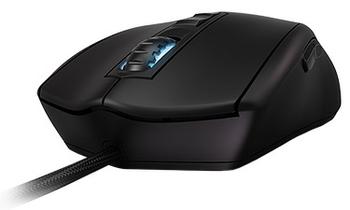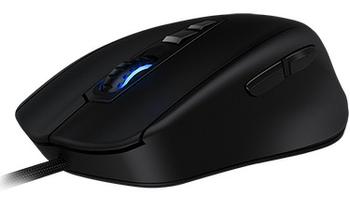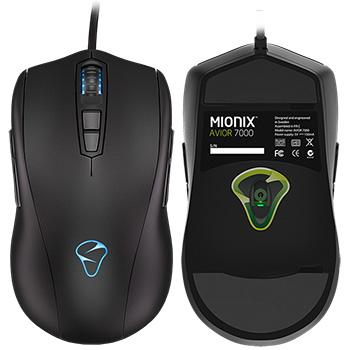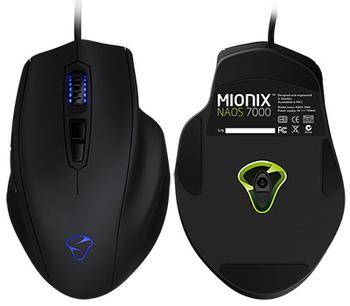High-End Optical Gaming
A recent HEXUS QOTW found that there are plenty of gamers out there using mice from familiar brands such as Microsoft, Logitech and Razer. It's a market that appears to be difficult for newcomers to break into, though not through a lack of effort or willingness.
One brand that's slowly but surely making inroads is Swedish outfit Mionix. Founded in 2007, the company, like so many others, has sights set exclusively on high-end gamers and has built up an attractive portfolio of products in next to no time.
The Avior 7000 and Naos 7000 mice, priced at £70 apiece, are two recent additions and both are under the microscope today.
This is our first outing with Mionix mice and initial impressions are good. Although targeted at hardcore gamers, both peripherals are coated in a soft-touch rubber that's comfortable under the skin and attractive in appearance.
There's a surprising amount of elegance to them, and though they're relatively subtle to look at, there's plenty of gamer-grade technology within. Both mice are equipped with a 32MHz ARM processor, customisable LED lighting, mouse buttons backed by Omron mechanical micro-switches and an ADNS-3310 optical sensor that promises no unwanted acceleration and a resolution of up to 7,000 DPI.
Choices, Choices, Choices
It's this sensor that sets the 7000-series models apart. Astute readers will know that Mionix already has 8200-series equivalents that are outfitted with an 8,200 DPI laser, so the new additions are all about offering choice. The existing laser models fetch a small premium at retail, are likely to track on a wider variety of surfaces, and would arguably offer greater accuracy, but the optical alternatives still offer a lot of what's good about the mice at a lower price point.
Then there's the matter of differentiating between the two. While both the Avior and Mionix are built around the same underlying technology, each is given a unique ergonomic design: the Avior is an ambidextrous device, while the Naos is sculpted exclusively for right-handers.
Sensor |
ADNS-3310 Optical |
ADNS-3310 Optical |
|---|---|---|
DPI |
up to 7,000 |
up to 7,000 |
Processor |
32-bit ARM @ 32MHz |
32-bit ARM @ 32MHz |
Ergonomics |
Ambidextrous, palm or claw grip |
Right handed, full palm grip |
Buttons |
9 |
7 |
DPI Adjustment |
3-step |
3-step |
Built-in Memory |
128KB |
128KB |
Polling Rate |
up to 1,000Hz |
up to 1,000Hz |
Dimensions (mm) |
125.3 x 65.0 x 36.6 |
130.8 x 84.7 x 38.7 |
Weight (w/o cable) |
100g |
103g |
Makes all the difference, too. As a righty with big hands, I found the Avior to be pleasant enough during use, but I immediately felt right at home with the Naos. There isn't a great deal of difference between the two in terms of size, but the Naos' extra width allows for shaped resting points for the ring and little fingers.
The result is a mouse that feels very comfortable under the palm, though, that's not to say the Naos 7000's form factor is perfect. The right ergonomics are always a personal thing, but for us, neither the Avior nor the Naos is heavy enough: at around 100g in weight, they almost feel hollow and it's a shame neither is equipped with an adjustable weight mechanism. Given the choice, we'd like to see around 20g added to each device.
It's interesting to note that the form-factor decisions also have an impact on button count. While the right-handed Naos 7000 is equipped with seven buttons, the Avior 7000 ups that count to nine by including a pair of thumb buttons on either side. The extra buttons could be thought of as a value-add, but that wasn't the case in our experience. When using the mouse right-handed, we found that the two additional thumb buttons would rub awkwardly against the index finger.
There isn't a great deal separating the two, but for right-handers the Naos 7000 is the obvious choice, and for lefties the Avior 7000 isn't a bad alternative. Each mouse is attached via a 2m-long braided USB 2.0 cable and is completely plug-and-play, and though there is software available, it's entirely optional.
The backlit, rubberised scroll wheel seems identical on both mice, with well-defined notches making it easy to judge a weapon change. It feels robust during use, yet it only supports vertical scrolling and not horizontal: a surprise omission for modern-day mice.
Just below the wheel are two dedicated DPI adjustment buttons that allow switching between three user-defined presets. By default, these are set at 400, 1,600 or 7,000 DPI. Toggling between modes is instant, though, unlike the 8200-series, there's no visual indicator to keep tabs on the current setting.






